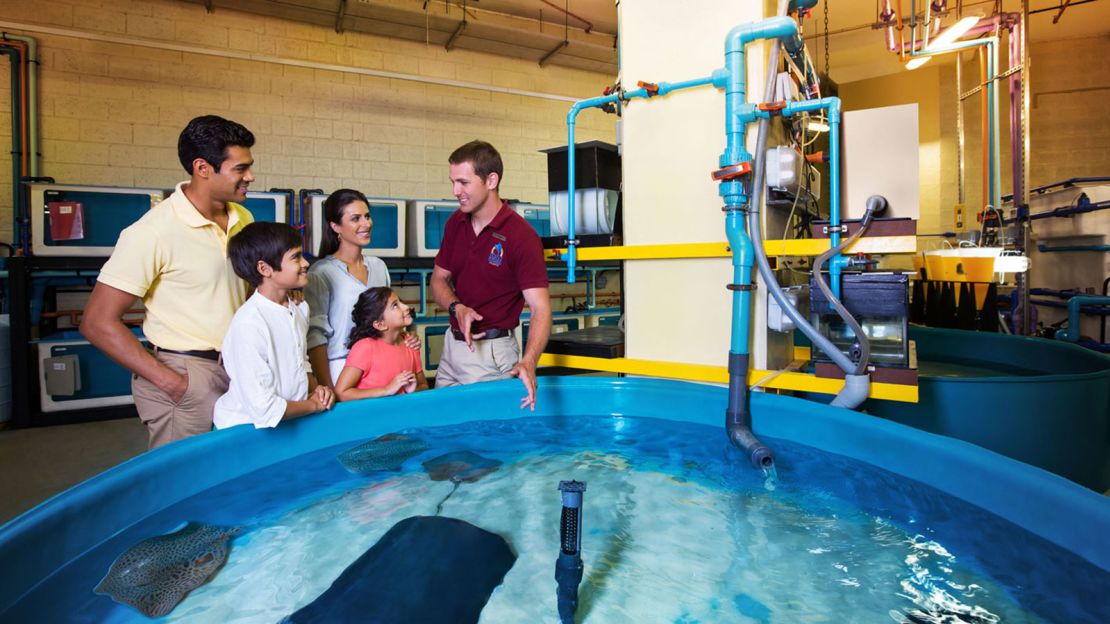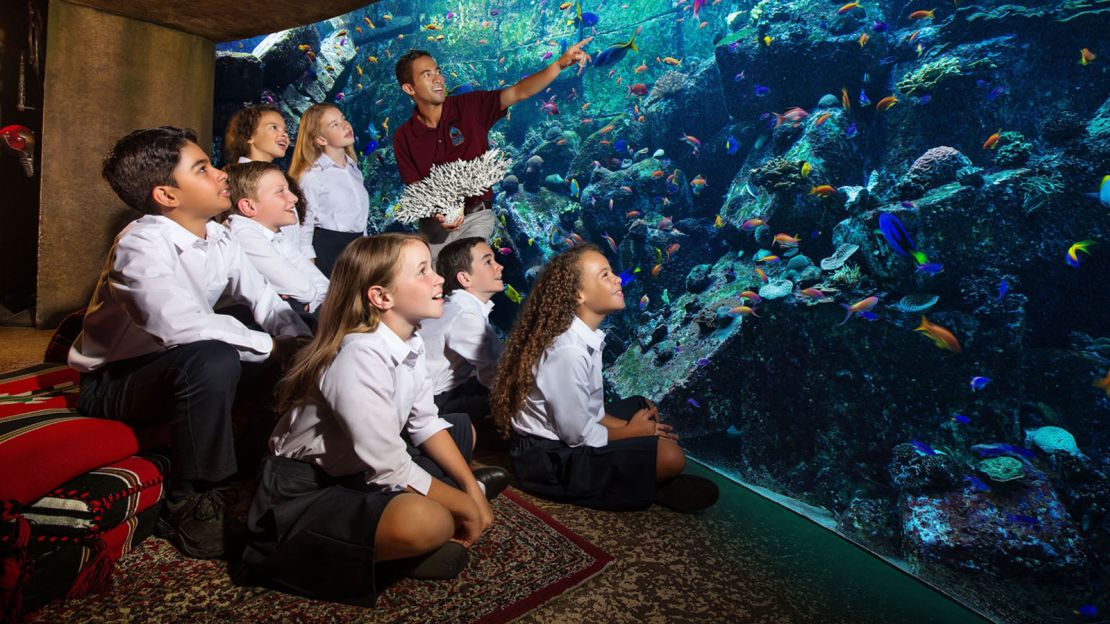At the end of Dubai’s Palm Jumeirah, famed for its five-star hotels and luxury villas, lies a high-tech medical facility with some of the most cutting-edge equipment on the market, including water-resistant ultrasound machines, portable X-rays, and a fully equipped blood and water analysis lab.
But this facility isn’t for human patients. It’s for fish.
It’s part of the Fish Hospital at Atlantis Dubai, the marine-themed resort that’s home to an aquarium filled with 65,000 underwater residents.
Looking after everything from tiny anthia fish to two-meter black-tipped reef sharks, more than 100 animal care specialists contribute to the work of the Fish Hospital. Aquarists, divers, marine educators and vets work alongside a life support team who take care of the water quality and ensure that all systems run smoothly.
“We aim to focus on preventative medicine rather than treatment,” says Ana Salbany, the hospital’s director of veterinary services, who has been a key member of the team for the past 11 years.
On an average day, Salbany and her team may find themselves conducting health assessments and ultrasound for pregnancies, taking blood samples, or X-raying potentially injured animals. This dedication to maintaining a healthy population has been a key factor in the aquarium being recognized with gold standard accreditation by the Association of Zoos and Aquariums (AZA).
The facility is housed in the depths of Atlantis in a spotless back-of-house area featuring tanks of all sizes, meters and meters of multi-colored pipes and valves, and various vessels with labels such as “Moon Jellyfish Ephyrae” and “24 Hour Artemia” which mean little to the uninitiated, but everything to the Fish Hospital team.

Breeding programs
Sickness is rare among the aquatic population here, but that doesn’t mean the hospital has quiet days. New animals joining the aquarium are quarantined here, and in the heat of the summer months it houses turtles from local rescue organizations, providing a safe, temperature-controlled environment.
It’s also where the aquarium’s breeding programs of moon jellies, corals and Arabian carpet sharks take place.
“We let the animals get on with being animals, and that means inevitably that some of them will mate,” explains Kelly Timmins, director of conservation, education and corporate social responsibility at Atlantis. With natural seawater and sunlight combined with a healthy well-fed population, the carpet sharks breed without any additional encouragement.
“When our divers find shark eggs in the lagoons they harvest them and bring them to the safety of the Fish Hospital nursery,” says Rob Bennett, manager of The Lost Chambers Aquarium. He’s been looking after the larger inhabitants, including the sharks and rays, since 2008.
Not all eggs will have been fertilized, but those that have are brought to the nursery to mature in peace. An Arabian carpet shark embryo will remain inside its egg, known as a “mermaid’s purse,” for nine to 12 months consuming the yolk contained in the sac and constantly moving to oxygenate the surrounding fluid. And when they emerge, they’re fully independent.
It’s this independence that makes them a viable species to be released into the wild. The Atlantis team works with Dubai Municipality to release a number of juvenile Arabian carpet sharks, considered a near-threatened species by the International Union for Conservation of Nature (IUCN), into the waters of the Arabian Gulf each year.

Shark Tale
This March, 10 sharks were released into the Jebel Ali Wildlife Sanctuary, a stretch of protected beach and coastline that provides a calm, safe environment for marine life. And their new home is quite the idyllic spot. This is the last beach in Dubai where hawksbill turtles lay their eggs, and the rich seagrass meadows offshore provide grazing for dugongs.
One of Salbany’s jobs is to make sure that any sharks transferred for release are healthy and in good condition. “We measure their weight, length and girth, and identify their sex before releasing them into the wild. There needs to be a correlation between weight and length to ensure they’re strong enough to fend for themselves.”
For the journey to their new home, the sharks are placed into a tank with natural seawater that is constantly oxygenated during the 30-minute drive. The release process is quick – each shark is carried down to the water in a sling, then allowed to swim away. After the release, the team combs the length of the beach to ensure that none of them have made it back to the shore or been washed up.
But why release the sharks? “We’re all conservationists at heart,” says Bennett. “The sharks are only small when they leave us, between two and three years, but a lot of effort goes into getting them this far.”
Arabian carpet sharks are naturally docile creatures, dwelling on the bottom of the seabed. Unlike fast-swimming sharks they don’t use their eyes to find food, instead using their moustache-like barbels and jelly-filled pores, called ampullae of Lorenzini, to seek out their next meal.
“It’s like a sixth sense for them”, says Timmins. “They use these pores to detect electrical currents coming from their prey, which could be crabs, crustaceans or anything else they find on the sea floor.” Even the tiniest heartbeat emits enough electricity for the shark to find its next meal.

A different kettle of fish
Food is an important concern for the animal care specialists back at the Fish Hospital, too. With prevention of disease rather than treatment being the main focus, the fishes’ diet has a major role to play in keeping the population healthy. In total, the inhabitants of the aquarium require between 350 and 400 kilograms of food per day (that’s 770 to 880 pounds).
“In summer we need a bit less because the natural sunlight on the lagoon helps algae form which is a great food source for some of our residents,” says Bennett.
But for the sharks, algae isn’t on the menu. “We provide a wide variety of different foods that includes squid, mackerel, shrimps, crabs and lobsters. And it’s all restaurant-grade, the same top quality that we serve to human guests in the hotel,” says Bennett.
And there’s also one unexpected ingredient in the mix. Garlic.
“We use 40 kilos of garlic each month,” says Bennett. “It’s great for the immune system and helps to keep away parasites.” And in winter, as temperatures decrease and natural algae doesn’t form in such high quantities, the diet is supplemented with vitamin-rich spinach and lettuce.
A major part of the work conducted by the aquarium and Fish Hospital team focuses on education. Guests of Atlantis can visit the facility and see what goes on behind the scenes. “We try our best to explain the richness of marine life in the Gulf to guests because there’s a lack of knowledge about our waters. People think that because it’s so hot, nothing lives here,” says Bennett.
But it’s not just about what lives locally. Broadening awareness of sharks in general and reducing the fear factor of this misunderstood species is a major focus for Bennett and his team.
“By showcasing the Arabian carpet sharks and the other sharks housed in our aquarium, we can show people that there’s a big diversity and that sharks don’t have to be ‘scary’,” he says. “A key part of protecting sharks is dispelling that myth, and this is an important part of the role we play here.”



